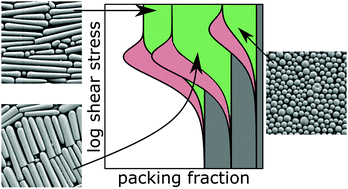Controlling shear jamming in dense suspensions via the particle aspect ratio†
Abstract
Dense suspensions of particles in a liquid exhibit rich, non-Newtonian behaviors such as shear thickening (ST) and shear jamming (SJ). ST has been widely studied and is known to be enhanced by increasing the particles' frictional interactions and also by making their shape more anisotropic. SJ however has only recently been understood to be a distinct phenomenon and, while the role of interparticle friction has been investigated, the role of particle anisotropy in controlling the SJ regime has remained unknown. To address this we here synthesize silica particles for use in water/glycerol suspensions. This pairing of hydrogen-bonding particle surfaces and suspension solvent has been shown to elicit SJ with spherical particles. We then vary particle aspect ratio from Γ = 1 (spheres) to Γ = 11 (slender rods), and perform rheological measurements to determine the effect of particle anisotropy on the onset of shear jamming. We also show that the effect on the precursor to SJ, discontinuous shear thickening (DST), is consistent with prior work. We find that increasing aspect ratio significantly reduces ϕm, the minimum particle packing fraction at which SJ can be observed, to values as low ϕm = 33% for Γ = 11. The ability to fix the properties of the solvated particle surfaces, and thus the particle interactions at contact, while varying shape anisotropy, yields fundamental insights about the SJ capabilities of suspensions and provides a framework to rationally design and tune these behaviors.



 Please wait while we load your content...
Please wait while we load your content...
